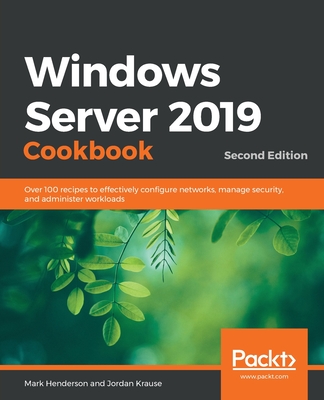-
 Microsoft Windows Server AppFabric Cookbook
Microsoft Windows Server AppFabric Cookbook- 出版日期:2012-05-18
- 貴賓價: $2,204 海外代購書籍(需單獨結帳)
-
 Windows Server 2012 Hyper-V Cookbook (Paperba
Windows Server 2012 Hyper-V Cookbook (Paperba- 出版日期:2012-10-22
- $990 立即出貨(限量)
-
 Windows Server 2016 Automation with PowerShel
Windows Server 2016 Automation with PowerShel- 出版日期:2017-09-21
- 貴賓價: $2,204 海外代購書籍(需單獨結帳)
-
 Windows Server 2012 Automation with PowerShel
Windows Server 2012 Automation with PowerShel- 出版日期:2013-03-24
- $940 立即出貨(限量)
-
 Windows Server Automation with PowerShell Coo
Windows Server Automation with PowerShell Coo- 出版日期:2023-01-31
- 貴賓價: $1,786 立即出貨
-
 Windows Server 2016 Administration Cookbook:
Windows Server 2016 Administration Cookbook:- 出版日期:2018-04-20
- 貴賓價: $1,254 海外代購書籍(需單獨結帳)
-
 Windows Server 2016 Security, Certificates, a
Windows Server 2016 Security, Certificates, a- 出版日期:2018-04-27
- 貴賓價: $1,254 海外代購書籍(需單獨結帳)
-
 Windows Server 2012 R2 Administrator Cookbook
Windows Server 2012 R2 Administrator Cookbook- 出版日期:2015-01-31
- 貴賓價: $1,881 海外代購書籍(需單獨結帳)
-
 Windows Server 2019 Automation with Powershel
Windows Server 2019 Automation with Powershel- 出版日期:2019-02-28
- 貴賓價: $2,204 海外代購書籍(需單獨結帳)
-
 Windows Server 2016 Hyper-V Cookbook - Second
Windows Server 2016 Hyper-V Cookbook - Second- 出版日期:2017-01-18
- $1,674 立即出貨
-
 Windows Server Automation with PowerShell Coo
Windows Server Automation with PowerShell Coo- 出版日期:2021-07-30
- $1,128 立即出貨
-
 ASP.NET Cookbook (Paperback)
ASP.NET Cookbook (Paperback)- 出版日期:2004-09-02
- $399 立即出貨(限量)
-
 SQL Cookbook: Query Solutions and Techniques
SQL Cookbook: Query Solutions and Techniques- 出版日期:2020-12-08
- 貴賓價: $2,242 立即出貨
-
 Zabbix 7 IT Infrastructure Monitoring Cookboo
Zabbix 7 IT Infrastructure Monitoring Cookboo- 出版日期:2024-07-12
- 貴賓價: $1,995 立即出貨
-
 Adobe Integrated Runtime (AIR) for JavaScript
Adobe Integrated Runtime (AIR) for JavaScript- 出版日期:2007-07-13
- $532 立即出貨
-
 DNS and BIND Cookbook
DNS and BIND Cookbook- 出版日期:
- $1,254 立即出貨
-
 Active Directory Cookbook, 3/e (Paperback)
Active Directory Cookbook, 3/e (Paperback)- 出版日期:2008-12-29
- $990 立即出貨(限量)
-
 Microsoft Exchange Server 2013 PowerShell Coo
Microsoft Exchange Server 2013 PowerShell Coo- 出版日期:2013-05-20
- $1,188 立即出貨(限量)
-
 Visual Studio 2012 Cookbook
Visual Studio 2012 Cookbook- 出版日期:2012-07-16
- 貴賓價: $1,596 海外代購書籍(需單獨結帳)
-
 Windows Server 2019 Cookbookm - Second Editio
Windows Server 2019 Cookbookm - Second Editio- 出版日期:2020-07-21
- 貴賓價: $1,881 海外代購書籍(需單獨結帳)
-
 JRuby Cookbook (Paperback)
JRuby Cookbook (Paperback)- 出版日期:2008-12-16
- $1,129 立即出貨
-
 Automation through Chef Opscode: A Hands-on A
Automation through Chef Opscode: A Hands-on A- 出版日期:2014-07-17
- 貴賓價: $2,290 海外代購書籍(需單獨結帳)
-
 Microsoft SharePoint 2010 and Windows PowerSh
Microsoft SharePoint 2010 and Windows PowerSh- 出版日期:2011-11-14
- 貴賓價: $1,568 海外代購書籍(需單獨結帳)
-
 Alfresco 3 Cookbook
Alfresco 3 Cookbook- 出版日期:2011-07-25
- 貴賓價: $2,204 海外代購書籍(需單獨結帳)
-
 Microsoft Exchange 2010 PowerShell Cookbook
Microsoft Exchange 2010 PowerShell Cookbook- 出版日期:2011-07-25
- 貴賓價: $2,204 海外代購書籍(需單獨結帳)
-
 Powershell Pocket Reference: Portable Help fo
Powershell Pocket Reference: Portable Help fo- 出版日期:2021-06-01
- 貴賓價: $1,045 立即出貨
-
 Nmap Network Exploration and Security Auditin
Nmap Network Exploration and Security Auditin- 出版日期:2021-08-27
- 貴賓價: $1,881 海外代購書籍(需單獨結帳)
-
 Powershell Cookbook: Your Complete Guide to S
Powershell Cookbook: Your Complete Guide to S- 出版日期:2021-07-20
- $2,831 立即出貨
-
 SQL Server Analytical Toolkit: Using Windowin
SQL Server Analytical Toolkit: Using Windowin- 出版日期:2023-09-24
- 貴賓價: $2,299 海外代購書籍(需單獨結帳)
-
 Linux Networking Cookbook
Linux Networking Cookbook- 出版日期:2008-01-01
- $1,520 立即出貨